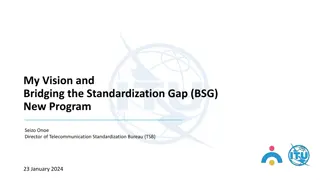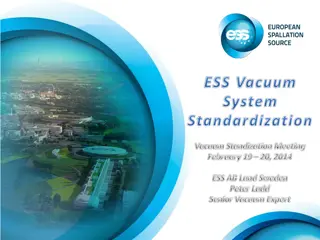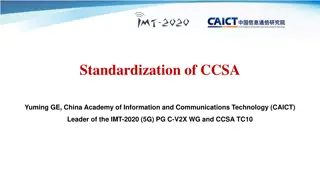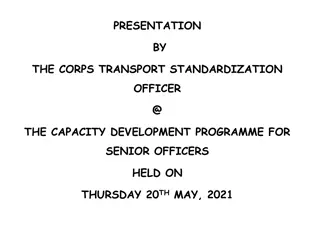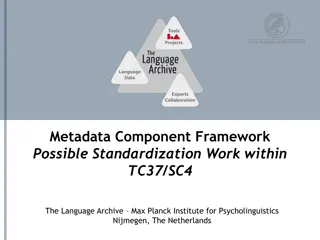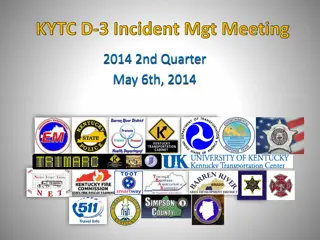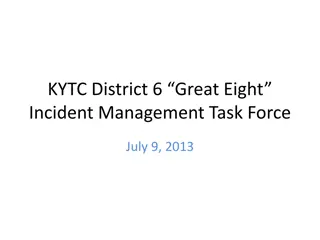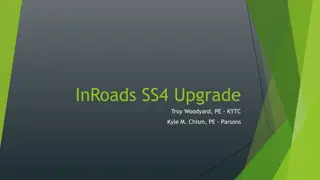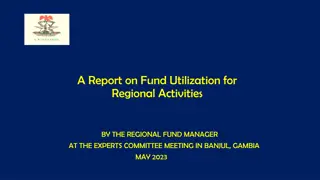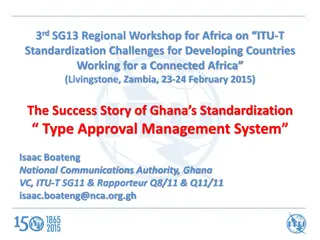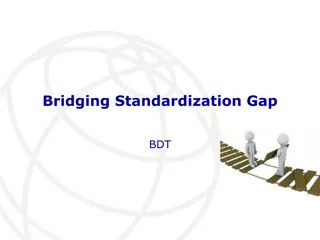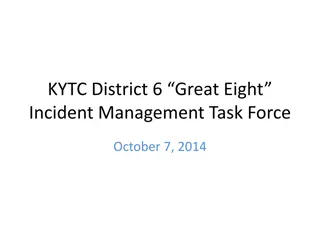Enhancements and Standardization to KYTC Regional Models
Presentation on KYTC's standardized procedures and enhancements for regional models, including standardized organization of model files, flow of regional TDMs, model scripting, interface design, and completed regional models by KYTC. The presentation highlights the use of various methodologies and data sources to improve travel demand modeling in Kentucky.
Uploaded on Oct 05, 2024 | 3 Views
Download Presentation

Please find below an Image/Link to download the presentation.
The content on the website is provided AS IS for your information and personal use only. It may not be sold, licensed, or shared on other websites without obtaining consent from the author.If you encounter any issues during the download, it is possible that the publisher has removed the file from their server.
You are allowed to download the files provided on this website for personal or commercial use, subject to the condition that they are used lawfully. All files are the property of their respective owners.
The content on the website is provided AS IS for your information and personal use only. It may not be sold, licensed, or shared on other websites without obtaining consent from the author.
E N D
Presentation Transcript
Enhancements and Standardization to KYTC Regional Models Presented to The Kentucky Model Users Group Presented by The Corradino Group Frankfort, KY April 18, 2016
Outline KYTC s Standardized Procedures for Regional Models TAZ Network flexibility 2 Truck Class Model TOD functionality KYTC s Regional Models Input BIN files Traffic Assignment Model Reporting
KYTCs Standardization of Regional TDM KYTC has developed a standardized travel demand modeling procedure. The District 9 regional model is the latest to use the procedure. 1. Standardized Organization of Model Files
Standard flow of Regional TDMs 2. Standardized Model Stream Same framework for regional models Identified methodologies for sub- models (e.g., 2010 HCM speed/capacity calculator, NCHRP 716 external trip model) TAZ/Network coding & fields requirement KYTC s default traffic assignment & feedback loop parameters (e.g., # of iterations, assignment convergence criteria) KYTC s highway assignment validation targets Flexible application of AirSage and other useful data sources for enhancing sub-models or model parameters
Standardization Script for Regional TDMs 3. Standardized Model Script Standardized macros for all model components Standard variable names Minimal hard-coded parameters (parameters saved in input BIN file) Track and Date of script changes
Standardized Interface of Regional TDM 4. Standardized Model Dialogue Model step controlled in main GUI Model Scenario Manager to manage scenarios, input, output & parameters
KYTCs Completed Regional Models Lexington/Central KY Region (2012) Owensboro/Henderson Region (2014) Bowling Green/Warren Co. (2014) E-town/Hardin Co./Meade Co. (2014) KYTC District 9 Regional Model (2015) District 9 Lexington Owensboro Elizabethtown Bowling Green
Regional Model TAZ Structure Ease in splitting zones (internal & external) Zones nest within KYSTM TAZs Generally conforms to census block boundary Zones approach homogeneous land use Incorporating adjacent counties to be sensitive to movement & external trips across Kentucky s boundary Zone numbering to improve spatial understanding of tabular maintenance & updates County Bath Carter Elliott Fleming Greenup Lewis Mason Rowan Adams Brown Scioto External Zone Total # of TAZ 38 99 26 50 84 55 117 91 16 14 30 74 694 ID Range 8000+ 2000+ 3000+ 7000+ 1000+ 4000+ 6000+ 5000+ 10000+ 9000+ 11000+ 15001 - 15074
Regional Model Zonal Data Household & Population 2010 census, KDC for future scenarios. Employment by type (service, retail, non-retail) KY zones geocoded ES202 & Non-KY zones LEHD data (census block) Vehicle ownership KY zones geocoded vehicle registration Non-KY zones US census (block group) K-12 enrollment Education Cabinet & KDC for future scenarios College enrollment - by college Workers, students (at home location) & Income US Census Area type Claritas Based initially on KYSTMv10 Special fields for +/- adjust for SU & COMB truck trips
Regional Model Network Networks include all Roads
Regional Model Networks Based on KYTC s Highway Information System (HIS) and roadway layers from other states. KY HIS field names retained as possible. Ultimate goal is for All roads to have minimal model attributes for a successful model run. (when In_Network>0) Inactive: In_Network = null or 0 (not included for skimming & assignment) Active for auto & truck: In_Network = 1 Active for auto only: In_Network = 2 Active for truck only: In_Network = 3 Active links include all roads with FC = Minor Collector or above and key local roads. Free-flow Speed & Hourly Capacity based on HCM 2010 Speed_Override and Directional HrlyCap_Override fields.
Regional Truck Model Regional Truck Model Components Single-unit truck (SU truck, FHWA class 4-7) Freight combination truck (COMB truck, FHWA class 8-13) FHWA class 3 (4-tire truck, e.g., pickups & vans) are merged into auto trips For KYTC s early review, truck models are developed first as soon as the model s TAZ /Network data is ready.
Regional Truck Model Time of Day Truck Time-of-Day (TOD) Factors Initially from KYTC s SU & COMB truck counts Rates are adjusted to balance time periods to counts Values are stored in the TOD.bin file TOD Factor Truck Type AM MD PM NT Internal Light (add to autos) 0.1851 0.4160 0.2019 0.1970 Internal SU 0.1851 0.4160 0.2019 0.1970 Internal Comb 0.1436 0.3918 0.1914 0.2732 EI_SU 0.1851 0.4160 0.2019 0.1970 EI_Comb 0.1436 0.3918 0.1914 0.2732
Regional Truck Model Assignment Flow/Count Ratio 0.994 1.084 1.321 1.046 Flow/Count Ratio 1.051 0.956 1.046 Area Type Flow Count % RMSE Volume Group Flow Count % RMSE Rural Town 98,719 64,434 13,479 176,632 99,279 59,419 10,206 168,904 42.6% 48.5% 66.0% 49.2% 0 - 2,000 2,000 - 5,000 Total 167,891 8,741 176,632 159,756 9,148 168,904 50.9% 16.0% 49.2% Second City Total Flow/Count Ratio 0.893 Functional Class Flow Count % RMSE Flow/Count Ratio 1.116 0.922 1.041 0.882 1.063 0.838 1.019 1.077 1.324 1.094 1.079 1.046 County Flow Count % RMSE Interstate Other Frwy/Expwy Principal Arterial Minor Arterial Major Collector Minor Collector Total 27,254 30,532 14.4% Bath Carter Elliott Fleming Greenup Lewis Mason Rowan Adams Brown Scioto Total 12,658 23,035 1,065 7,456 26,093 4,686 17,863 16,667 11,984 14,999 40,030 176,632 11,346 24,991 1,023 8,451 24,541 5,589 17,533 15,482 9,050 13,715 37,111 168,904 33.7% 31.4% 51.4% 28.8% 40.0% 60.7% 44.8% 50.5% 93.2% 42.0% 55.9% 49.2% 1,005 1,203 28.4% 0.835 72,107 41,619 32,942 1,277 176,632 71,415 36,896 27,809 883 168,904 38.6% 56.3% 89.3% 120.2% 49.2% 1.010 1.128 1.185 1.446 1.046 Global truck attractions are in the Arates.bin file: By MED/HEAVY (SU/COMB) By Household & Employment (Basic/Retail/Service) Tip: When adjusting rates, focus on County with greatest truck counts
External Trip factors Final External Trip factors establish E-E/E-I splits & an EE seed trip table by vehicle class (Auto, SU truck, COMB truck) through a sub-area extraction of KYSTMv10. External trip table resides in the Externals.bin file. E-E seed trip table resides in the ee_seed.mtx file.
Regional Model Trip Generation Internal Trip Purpose HBW, HBO, NHB, HBSch, HBU, Light truck, SU truck, COMB truck Trip Rates are initially base on existing calibrated models. Final rates are ultimately unique to the region. Rates are kept in the Prates.bin file Attraction Rates ProductionRates Basic Emp. Retail Emp. Service Emp. Total Emp. 2.244 Univ. Enroll. K-12 Enroll. Purpose Vehicle Class 0 Veh 1 Veh 2 Veh 3+ Veh Vehicle Class 0 Veh 1 Veh 2 Veh 3+ Veh Vehicle Class 0 Veh 1 Veh 2 Veh 3+ Veh Vehicle Class All Class Vehicle Class All Class 0 Worker 0.00 0.00 0.00 0.00 1 Person 0.86 1.37 1.44 1.44 1 Person 0.50 1.01 1.15 1.15 1 Worker 1.10 1.10 1.43 1.43 2 Person 2.16 2.52 2.59 2.59 2 Person 1.22 1.66 1.87 1.94 Total Households 1.81 Total Households 1.21 2 Worker 2.64 2.86 2.86 2.86 3 Person 3.24 4.46 4.46 4.46 3 Person 1.44 2.52 2.81 3.24 3+ Worker 5.61 5.61 5.61 5.61 4+ Person 5.24 5.79 6.26 6.71 4+ Person 2.71 2.81 3.99 4.52 Purpose HH HBW HBO NHB HBSchool HBU HBW 1.00 0.78 0.30 0.91 5.90 3.38 2.30 1.30 Purpose 1.46 1.39 HBO Purpose NHB Purpose HBSchool Purpose HBU
Regional Model Trip Generation E-I Trip Generation (auto, SU truck, COMB truck) Production traffic counts Attraction NCHRP 716 (assume no I-E trips for an area with rural boundary) ? ??= ????? ??= EI trips generated in internal TAZ j ?? = total internal attractions for TAZ j ?? = distance from TAZ j to the nearest external station (by station type) A,B = calibrated parameters External Station Type Arterial near Expwy 0.5636 0.5452 1.7974 -1.2850 -1.1565 -1.0280 Frwy & Expwy 0.2061 0.1877 1.4680 -1.0000 -1.0000 -1.0000 Arterial Not Near Expwy 1.5246 1.5396 1.7796 -1.5170 -1.3653 -1.2136 Collector & Local 0.3658 0.3329 0.4598 -1.4820 -1.3338 -1.1856 Coefficient Purpose EI_Auto EI_SU EI_Comb EI_Auto EI_SU EI_Comb A B Parameters A & B resides in EI_Coefficient.bin file.
Regional Model Time of Day Factors Time-of-Day (TOD): AM Peak, Mid-day, PM Peak, Night TOD Factor D Factor (P to A) Trip Purpose AM MD PM NT AM MD PM NT HBW 0.2075 0.3149 0.2260 0.2516 0.9412 0.4901 0.1576 0.3903 HBO 0.1214 0.3439 0.2190 0.3158 0.8487 0.5410 0.4172 0.3446 NHB 0.1350 0.4136 0.2454 0.2059 0.5000 0.5000 0.5000 0.5000 HBSchool 0.3962 0.2953 0.3085 0.0000 0.9937 0.2851 0.1282 0.1714 HBU 0.3683 0.2744 0.2867 0.0706 0.9937 0.2851 0.1282 0.1714 EI_Auto 0.1403 0.3469 0.2299 0.2830 0.8487 0.5410 0.4172 0.3446 EE 0.1345 0.3632 0.2281 0.2743 0.5000 0.5000 0.5000 0.5000 TOD factors of HBW, HBO, NHB & EE initially from AirSage. TOD factors of HBSchool & HBU initially from NCHRP 716. Adjustments are required. Models assume no HBSchool trips at night period. Directional factors are directly from AirSage PA tables or NCHRP 716. TOD factors are in the TOD.bin file
Regional Model Auto Occupancy Rates Purpose AM Peak Mid-day PM Peak Night HBW 1.05 1.06 1.07 1.06 HBO 1.69 1.81 1.69 1.81 NHB 1.43 1.78 1.65 1.78 HBSchool 1.90 1.90 1.90 1.90 HBU 1.14 1.14 1.14 1.14 Auto occupancy rates are kept in the Occupancy.bin file.
Regional Model Assignment User Equilibrium (UE) algorithm For each time period, trucks are pre-assigned on an all-or-nothing basis while autos are assigned using BPR function and truck PCE=1.5. Convergence criteria = 0.0001. TOD flow is sum of all loaded vehicles for each time period. TOD flows are then summed to get daily flows. Trip distribution to assignment feedback loop. The MSA (method of successive average) process is used to determine convergence. Convergence is achieved when RMSE% < 1% for travel time matrices between current and successive iterations.
Regional Model - Reporting Reports are stored in a .xml file Report has a table of contents. Easy to copy to Excel/Word without re-format It will take longer to open the file after several model runs. (Can rename the file) Trip zonal data summary Trip distribution summary Highway assignment summary Check for base year Assignment validation report System performance report Check for future year User can control assignment report generation in model interface. For the base year, check Create Evaluation Report button to generation both validation & system performance reports. For a future year, check Create Forecast Report button to only generate system performance report.
Regional Model Validation Report Example Report Reports by Daily Each time period Vehicle class (auto, SU truck, COMB truck, total truck, total vehicle) Each series includes Summary statistics RMSE by volume group RMSE by facility type RMSE by area type RMSE by county Screenline analysis (only for total vehicle)
Regional Model Assignment Validation Model Volume 260,511 137,789 117,139 67,205 94,666 45,561 36,400 46,963 65,844 92,076 Traffic Counts 253,794 113,757 122,982 70,751 101,249 38,305 35,374 46,385 69,708 86,065 Max Desired Deviation% 17.4% 23.6% 22.9% 28.3% 24.7% 35.8% 36.9% 33.2% 28.5% 26.3% Screenline Deviation% 1 Regional Cordon 2 US 52/State Border Cutline 3 I-64 Cutline 4 KY 9 Cutline 5 KY 32 Cutline 6 OH 32 Cutline 7 Rowan County Condon 8 Maysville Cordon 9 Flatwoods Condon 10 Portsmouth Condon 2.6% 21.1% -4.8% -5.0% -6.5% 18.9% 2.9% 1.2% -5.5% 7.0% Screenline results are automatically reported.
Regional Model Assignment Validation Time-of-Day Assignment RMSE % PM 53.5% 23.2% n/a 0.938 Volume Group AM 55.0% 36.5% n/a 1.010 MD 62.8% 28.9% 14.2% 0.955 NT Target Range > 55% 45 - 55% 35 - 45% 0 - 2,000 2,000 - 5,000 5,000 - 10,000 Model VMT/Count VMT 58.5% 25.2% n/a 0.963 TOD assignment is automatically reported by Volume Group Functional Class Area Type County Screenline
Regional Model System Performance Example Report Reports by All vehicles Auto SU truck COMB truck Total truck Each series includes (by county & by functional class) VMT VHT Average speed
Summary of Findings Regional Models represent our state of modeling practice for macro models in Kentucky. KYTC s standardized procedure makes travel demand modeling use consistent, transferable techniques between areas, and flexibility to improvements. OD data from AirSage is useful and cost-effective particularly for trip distribution, time-of-day and directional factors. AirSage adaptable to develop area type factors for trip generation. AirSage trip tables refinement & adjustment essential. Estimation of medium (SU) and heavy freight (COMB) truck trip generation significantly improves zone splitting. Truck model can be adjusted to match available information. The NCHRP 716 approach for external trip estimation works well for study areas with rural boundary in Kentucky. Model parameters are transferable between areas in Kentucky as initial values. HBW trip rates, friction factors of internal person trips & external truck trips, and TOD factors can be adjusted for area-specific values.
Questions ? Scott Thomson, PE KYTC Scott.Thomson@ky.gov, 502.782.5086 Jayalakshmi Balaji, PE KYTC Jayalakshmi.balaji@ky.gov, 502.782.5045 Ken Kaltenbach, PE Corradino kkaltenbach@Corradino.com, 502.587.7221 Johnny Han, PhD, PE Corradino jhan@Corradino.com, 317.744.9858
Using KYTC Regional Models Presented to The Kentucky Model Users Group Presented by The Corradino Group Frankfort, KY April 18, 2016
Outline KYTC s Model User Agreement Network Flexibility Speed & Capacity Adjustment Zone Splitting Truck Model Adjustment Select Link Analysis OD data
KYTCs Model Transfer Models are initially developed by consultants under KYTC s guidance Models comply with KYTC s standardization Models are enhanced by KYTC and consultants as needed upon KYTC s model review (this could be a few rounds) Key to Success KYTC s Standardization Shared Resources Effective Communication & Coordination between KYTC and Consultants
Network Flexibility Field In_Network is used to control link usage by vehicles. Null or 0 = inactive links (not used by model) 1 = active for all vehicles 2 = active for auto only 3 = active for truck only
Speed/Capacity Overrides Network fields Speed_Override and HourlyCap_Override (AB/BA) are used to override free-flow speed & capacity calculated by HCM 2010 methods as needed 3rd party data source Improved model calibration/validation
Zone Splitting 1. Split Zones (based on homogeneous land use) 2. Update zonal SE data (ensure original zonal totals equal the sum of all subdivisions) 3. Update network (ensure new centroid IDs match new TAZ IDs)
Zone Splitting 4. Update K-factor matrix Used by HBSchool trip distribution Value = 1 or 0 (intra- county OD flow or not) Matrix dimension must match TAZs Improved approach/script reduces error reporting caused by matrix dimension issues
Truck Model Adjustment Truck Generation Rates QRFM II starting point Adjusted by ODME Internal Truck (non-intrazonal) SU Truck COMB Truck Trips by QRFM II 18,140 6,369 Target Totals by ODME 23,763 11,323 Adjusting Factor 1.31 1.78 Truck Special Generators TAZ fields SG_MdTrk & SG_HvyTrk Represent zonal additive truck trips (+/-) final trucks = initial trucks + 0.5 * SG_MdTrk or SG_HvyTrk Useful in model calibration
Select Link Query Options Select Link Analysis show where the traffic that pass through a specified set of links/zones go to and/or come from. 2 ways to define select links/zones TransCAD Select Link/Zone Query Builder Select Link Control File ( *.qry, can be opened & edited in text editor) And/Or operators for links & nodes
Select Link Query Options Select Link Volume reported by Daily Each time period Vehicle class (auto, SU truck, COMB truck) Direction
OD - Background No current household OD survey data. No NHTS add-on. Lower cost compared to traditional household travel surveys. KYTC first purchased OD data for Lexington Area MPO model KYTC and Corradino have gained thorough insight in the use of OD data from AirSage for model development. For District 9 Regional Model, OD data was collected using an initial 500-zone structure. (resolution limit = 0.25 mi square) AirSage OD data provides internal-internal trips within the model area by purpose and time period. If data collection area is large enough, external trip information can be obtained from AirSage.
Data Pre-processing using AirSage Create TransCAD matrix files from AirSage (.CSV) Time Periods (Comes as five periods) AM peak = 6:00-9:00 Mid-day = 9:00-15:00 PM peak = 15:00-18:00 Night = 18:00-24:00 & 0:00-6:00 Trip Purpose: (H-home, W-work, O=other) HBW = HW, WH HBO = HO, OH, HH NHB = WO, OW, WW, OO The 500-zone OD table is used for trip generation, time-of-day and directional factor analysis. A refined 620-zone OD table (the final internal TAZs) is used for friction factor development.
AirSage Coverage Assessment 85% of 500 zones had data. Covered Zones 426 426 428 Uncovered Zones 74 74 72 Total Zones 500 500 500 Origin Zone Destination Zone O + D Zone Uncovered zones are typically in rural areas with low population (7% of area in the District 9 model) Uncovered areas are a function of poor cellular service
AirSage Cautions AirSage trips by purpose must be evaluated. Will effect trip generation rates. AirSage Calibrated D9 Model Internal P's 160,704 466,274 258,846 885,824 Purpose Internal P's 118,429 654,781 355,881 1,129,090 Internal A's Internal A's HBW HBO NHB Total 118,429 654,781 355,881 1,129,090 159,215 484,083 250,000 893,298 Daily I-I Person Trip/HH 9.6 7.6 Analysis is generalized due to resolution limits & aggregate data. AirSage can provide trip data that is normalized to census population as well as multiple carriers. With multiple carriers, averaging the two sets minimizes data bias. Initial AirSage OD table needs refinement (an ODME process is recommended) before analysis
AirSage Trip Length Distribution Refined AirSage data yields reasonable TLFD & mean trip lengths. AirSage Trip Length Frequency Distribution 12% AirSage mean trip length HBW HBO NHB 10% HBW 16.8 min 8% HBO 13.3 min 6% NHB 15.3 min 4% 2% 0% 0 10 20 30 40 50 60 Travel Time (min) Friction factors are developed for HBW, HBO and NHB, using TransCAD s gravity model calibration function.
Questions ? Scott Thomson, PE KYTC Scott.Thomson@ky.gov, 502.782.5086 Jayalakshmi Balaji, PE KYTC Jayalakshmi.balaji@ky.gov, 502.782.5045 Ken Kaltenbach, PE Corradino kkaltenbach@Corradino.com, 502.587.7221 Johnny Han, PhD, PE Corradino jhan@Corradino.com, 317.744.9858






